Copper is everywhere: in the wires that power our homes, the electronics we use daily, and the infrastructure that keeps the world moving. But how do we extract this essential metal in a way that makes sense for both the economy and the environment? Enter heap leaching, a smarter, cleaner, more efficient method of copper extraction that works hand in hand with traditional mining to maximize recovery while minimizing environmental impact. Nuton’s bio-heap leaching technology takes this process even further, using the power of bacteria to extract more copper with less chemicals and less impact on the earth.
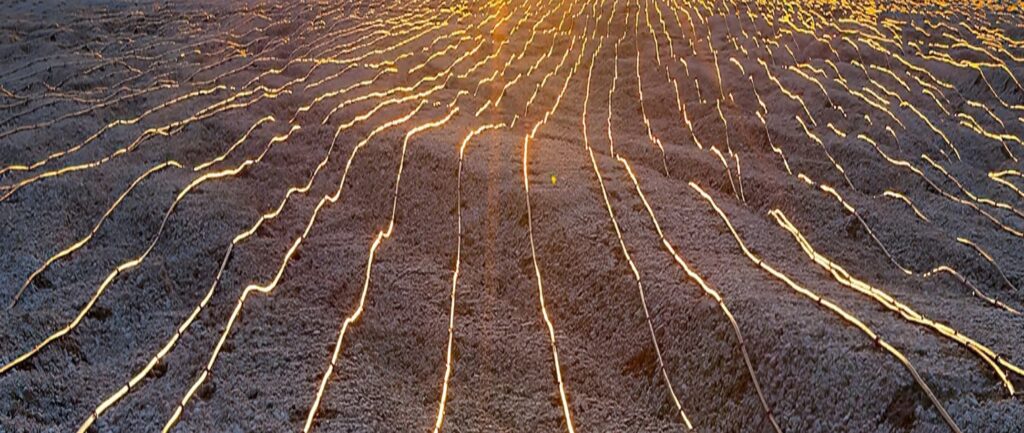
Chemical heap leaching: process and downsides
Chemical heap leaching has been around since the 1700s, and has since been widely adopted alongside—or in place of—traditional mining techniques. By trickling a sulfuric acid solution over heaps of crushed ore, miners can extract more copper at lower costs. This method is surface-based and uses impermeable liners to prevent contamination, making it an efficient choice for many operations.
But while chemical heap leaching is effective, it comes with trade-offs. The process relies on strong chemical solutions that must be carefully managed to prevent environmental damage. Plus, producing and handling these chemicals requires energy, adding to the overall footprint of the process. It’s a step in the right direction, but there’s a better way.
Bio-heap leaching: a superior and sustainable solution
What if we could harness nature to do the heavy lifting? That’s exactly what Nuton’s bio-heap leaching technology does. Instead of relying on harsh chemicals, it uses microorganisms—tiny but mighty—to break down copper minerals more efficiently. This not only reduces the risk of contamination but also cuts down on energy use, making it a cleaner, smarter approach.
And the benefits don’t stop there. Bio-heap leaching can recover up to 85% of copper from ores, which means more copper from the same volume of material. This process helps in reducing waste and making operations more cost-effective. It’s also incredibly versatile, working on challenging sites, including brownfield and legacy mining areas, where traditional methods struggle.
“Bio-heap leaching can recover up to 85% of copper from ores, which means more copper from the same volume of material. This process helps in reducing waste and making operations more cost-effective.”

Paving the way in sustainable copper leaching
As the world’s demand for copper grows, so does the need for more sustainable ways to extract it. Nuton’s bio-heap leaching technology leads the charge, turning mining into a cleaner, more efficient process. While chemical heap leaching offers advantages, bio-heap leaching enhances them by improving recovery rates and slashing environmental impact.
Innovative leaching methods like these are paving the way for a future where mining and sustainability go hand in hand. And that’s good news for everyone.
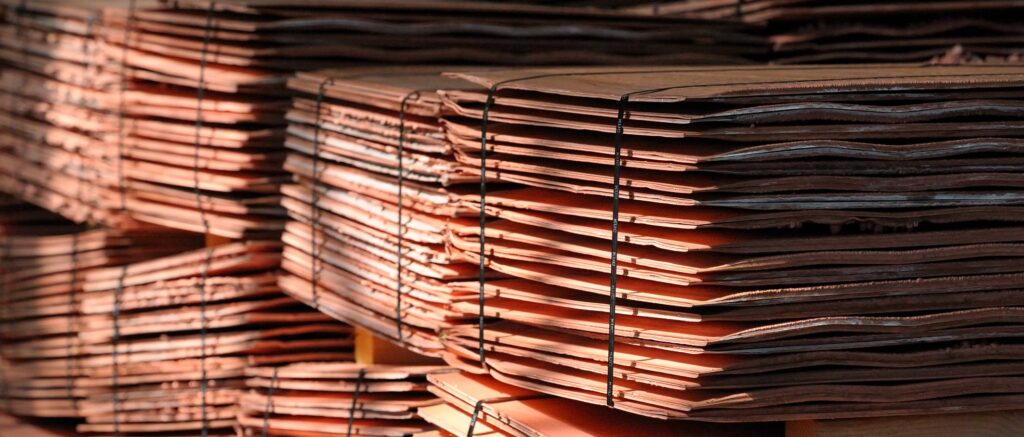
Another round of awards honors Nuton. This time, the 2025 Mining Technology Excellence Awards honor Nuton for three awards, underscoring its role in transforming the industry through sustainable mining practices.
“We are honored by this recognition, a testament to a hard-working and dedicated Nuton team,” says Adam Burley, Nuton Chief Executive Officer. This distinction arrives as Nuton achieves First Copper production from its industrial-scale deployment at the Johnson Camp Mine in Arizona, validating its decades of research. “Nuton brings together the spark of people, the intelligence of nature, and the power of technology to open new pathways for copper production.”



Innovation Award for bioleaching technology
The Innovation Award recognizes Nuton for its groundbreaking bioleaching technology, which significantly enhances copper recovery rates. Mining Technology adds, “This combination of advanced science and applied engineering not only matches but often surpasses the performance of traditional concentrator and leach technologies, solidifying Nuton’s position as a leader in mining innovation.”
Business Expansion Award for partnership and workforce growth
The Business Expansion Award honors Nuton for strategic partnerships across the Americas that facilitate rapid growth and access to new resources. The award profile notes, “The company’s impressive growth trajectory is evidenced by a tenfold increase in its workforce, expanding from just four to over 50 experts across engineering, technology, sustainability, and commercial functions.”
Environmental Stewardship Award for reduced emissions and water usage
The Environmental Stewardship Award celebrates Nuton for its low-impact processing methods that drastically reduce emissions and improve water efficiency. The feature observes, “This innovation not only minimizes the ecological footprint of mining operations but also addresses regulatory challenges associated with land permits for tailings and long-term waste management.”
In summary, these three wins reinforce Nuton’s impact on sustainable copper mining innovation. Nuton’s technology extends mine life and maximizes resource use by extracting value from ores that would otherwise be classified as waste, increasing yield and revenue at both new and existing mines. Its environmental performance is expected to exceed that of conventional copper processing technologies, with up to 80% less water use and up to 60% lower carbon emissions than the traditional concentrator route.
The Mining Technology Excellence Awards honor the most significant achievements and innovations in the global mining industry. Powered by GlobalData’s business intelligence, the Awards recognize the people and companies driving positive change and shaping the industry’s future.
Nuton’s first copper milestone marks a new era of smarter, cleaner, copper production
After decades of research and innovation, Nuton has achieved a major milestone: producing its first copper cathode using its industry-leading bioleaching technology at Johnson Camp Mine (JCM) in Arizona.
What began in a small lab in Bundoora, Australia, has scaled to full industrial operations – proving that cleaner, smarter copper production is possible at industrial scale.
“This is a pivotal moment for Nuton,” says Adam Burley, Nuton CEO. “We’re not just advancing technology – we’re setting a new standard for the industry and proving what’s possible: fast and at scale. We are incredibly proud of the team and excited for what is to come, which is validating and sustaining the technology’s performance.”
This milestone marks Nuton’s official entry into commercial operations and is a pivotal step in redefining how copper is produced. The Nuton® technology enabled the restart of JCM, owned by Gunnison Copper Corp, and moved from concept to cathode in just 18 months.
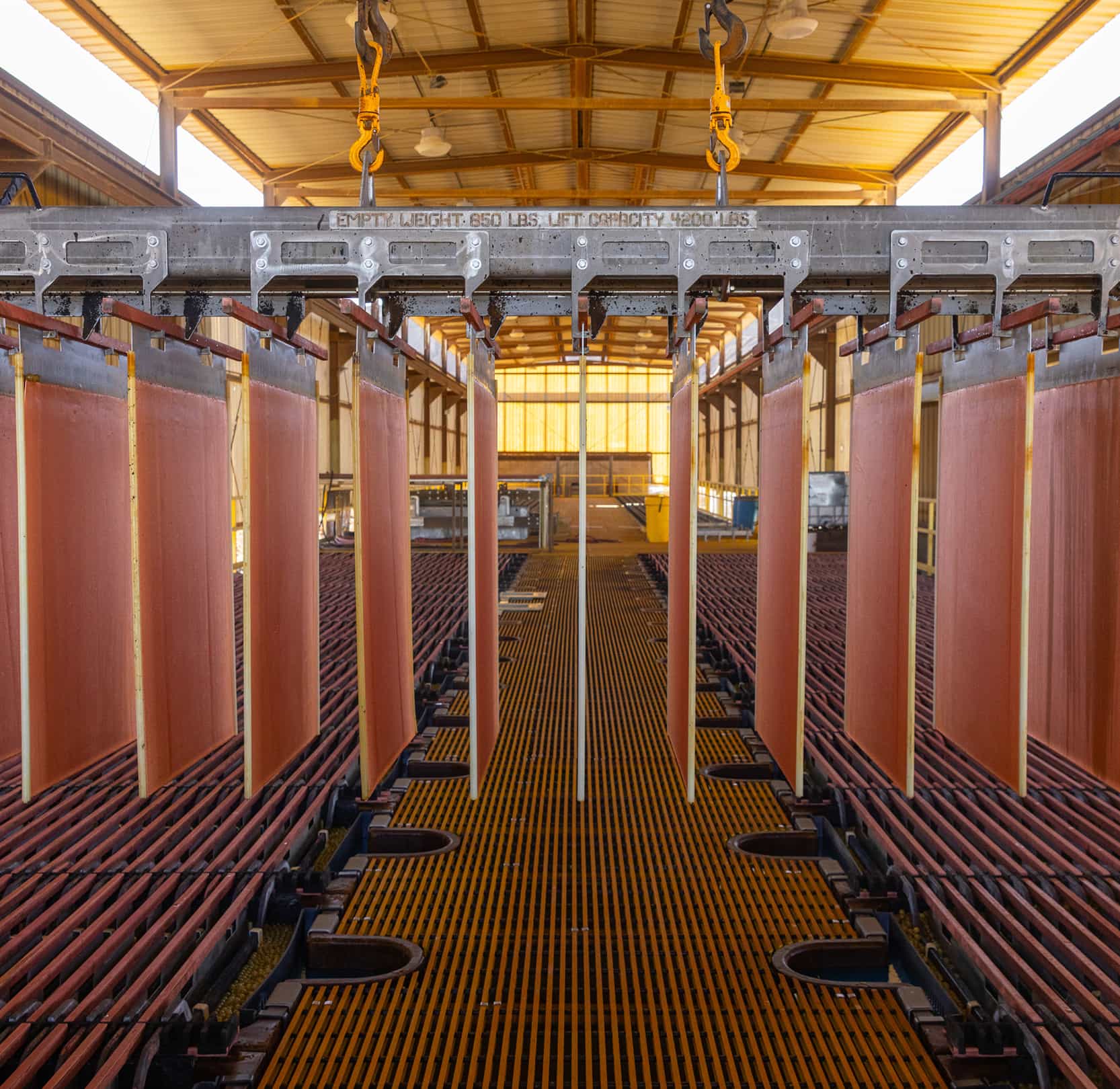
Go inside Nuton’s first copper
Watch how this milestone mine-to-market technology is reshaping the copper industry.
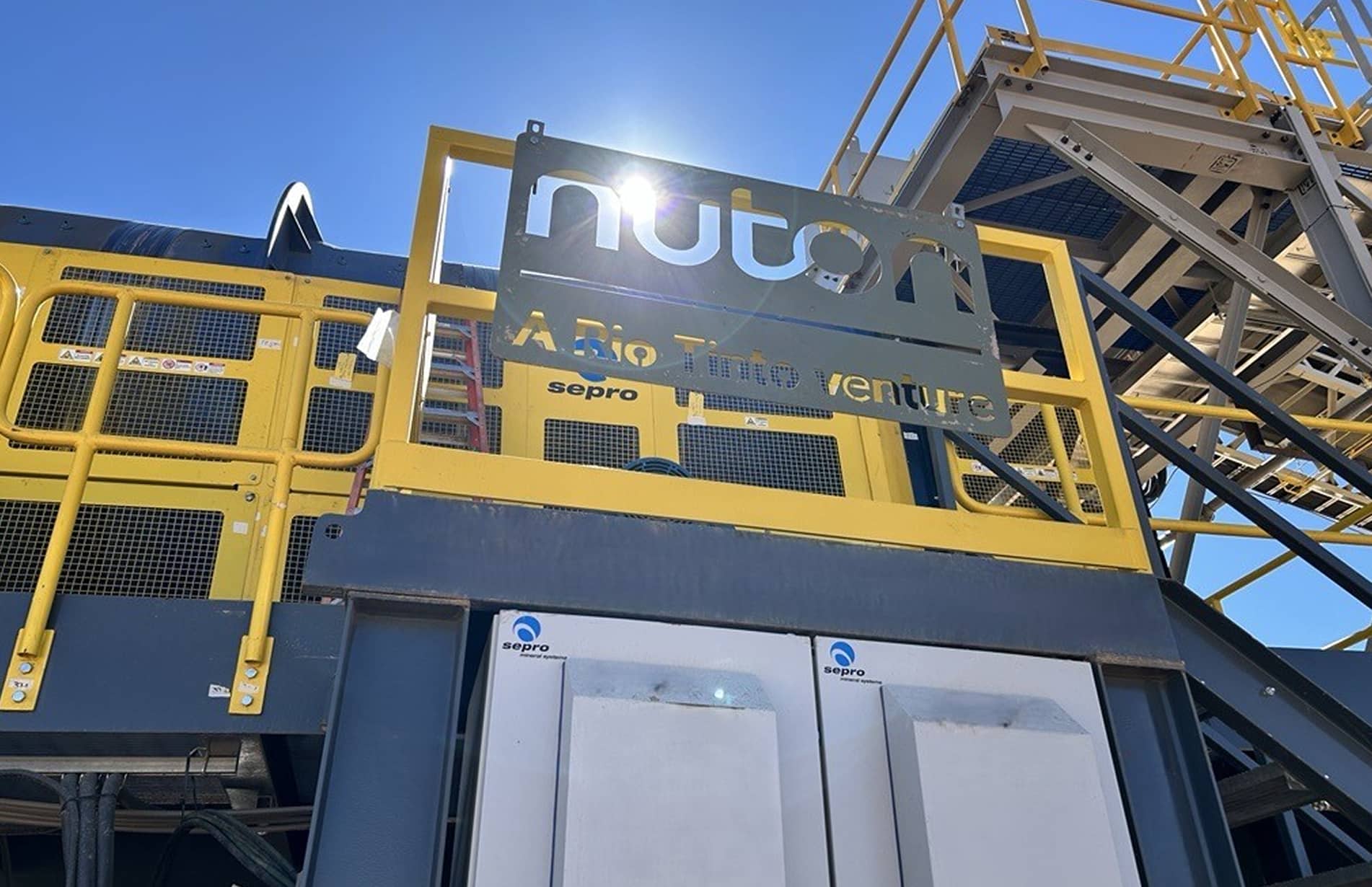
Rapid scale-up: concept to cathode in 18 months
One of the most significant aspects of Nuton’s achievement is the speed of its progress – from concept to cathode in just 18 months – an unprecedented speed in Rio Tinto. This included recommissioning the mine, constructing new infrastructure, and deploying proprietary equipment.
Nuton’s approach is different from the norm – offering a modular ‘brick-like’ system that can be deployed as part of a technology package that integrates biology with chemistry, engineering, and digital tools. By embedding advanced systems like AI, data analytics, and adaptive process controls into every layer of the JCM operations, Nuton is building a truly intelligent, responsive system. This digital backbone enables predictive insights and continuous improvement, making the system not only efficient but intelligent.
Pioneering the science of smarter copper: up to 85% recovery and unlocking copper faster
At the heart of this achievement is Nuton’s revolutionary technology, which harnesses the power of naturally occurring bacteria to extract copper from ores. These microbes are grown in Nuton’s proprietary bioreactors and then added to heaps of crushed ore. They speed up the breakdown of minerals, creating heat and allowing copper to dissolve into a liquid solution, which is then refined into copper cathodes that are 99.99% pure.
And a key differentiator? Up to 85% recovery of copper from primary sulfide ores – often considered too complex or uneconomical to process – where over 70% of the world’s untapped copper lies.
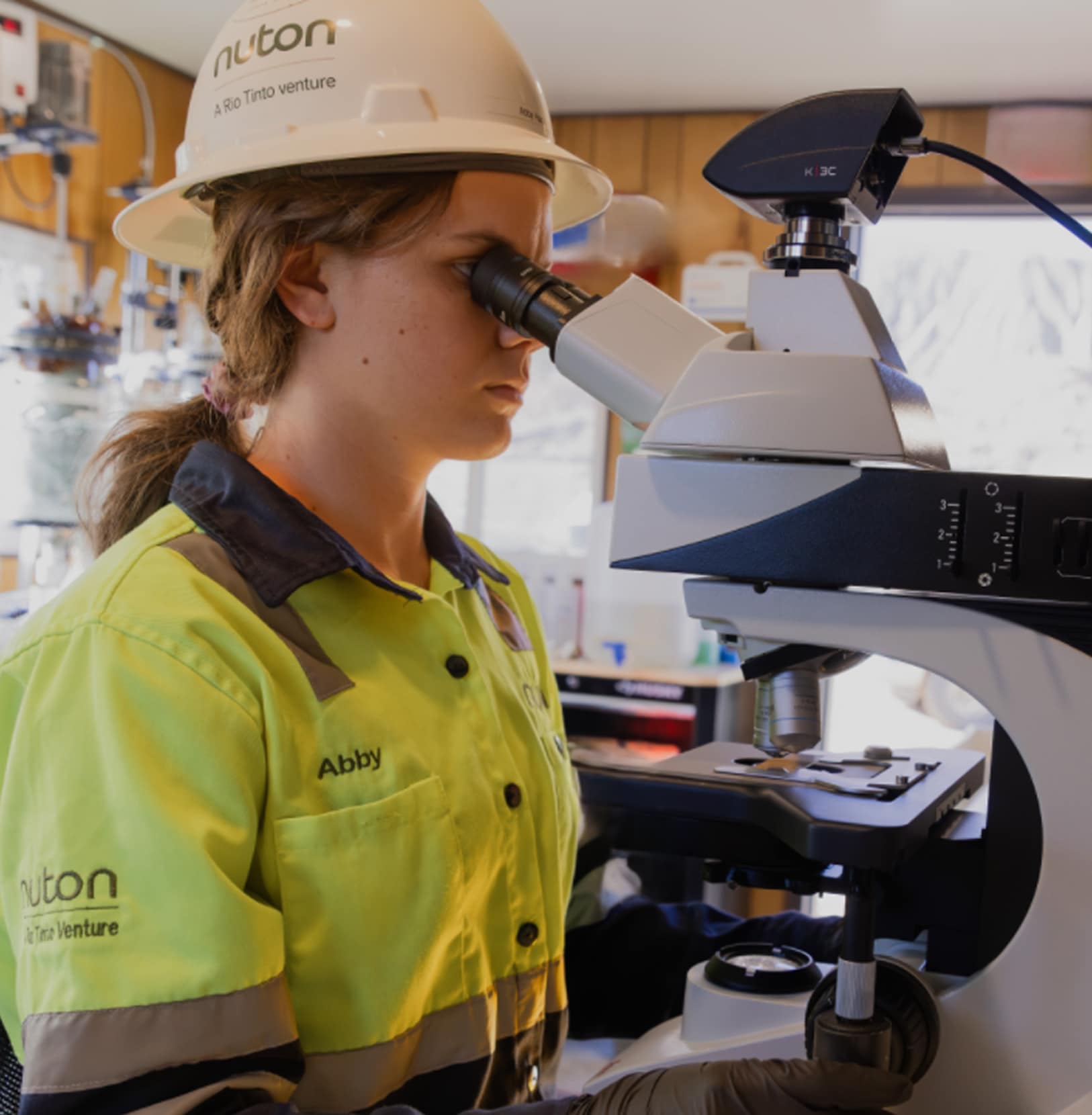

Transforming the copper industry with the lowest-carbon copper in the US
Nuton’s technology, along with investment in renewable technology, will position JCM to become the lowest-carbon copper producer among US copper mines.
A new three-year investment in Renewable Energy Certificates ensures that 100% of JCM’s electricity consumption is matched by U.S. or Canadian renewable energy generation, mitigating all Scope 2 emissions.
A recent ISO-certified Life Cycle Assessment (LCA) prepared for JCM indicates copper produced at site, combined with the purchase of RECs, will result in a mine-to-metal carbon footprint of just 0.82kg CO2-e per kilogram of copper, compared to the projected 2026 global of 3.4 kg CO2-e per kilogram of copper.
Centennial plant (Agave Americana) at JCM
First copper by the numbers
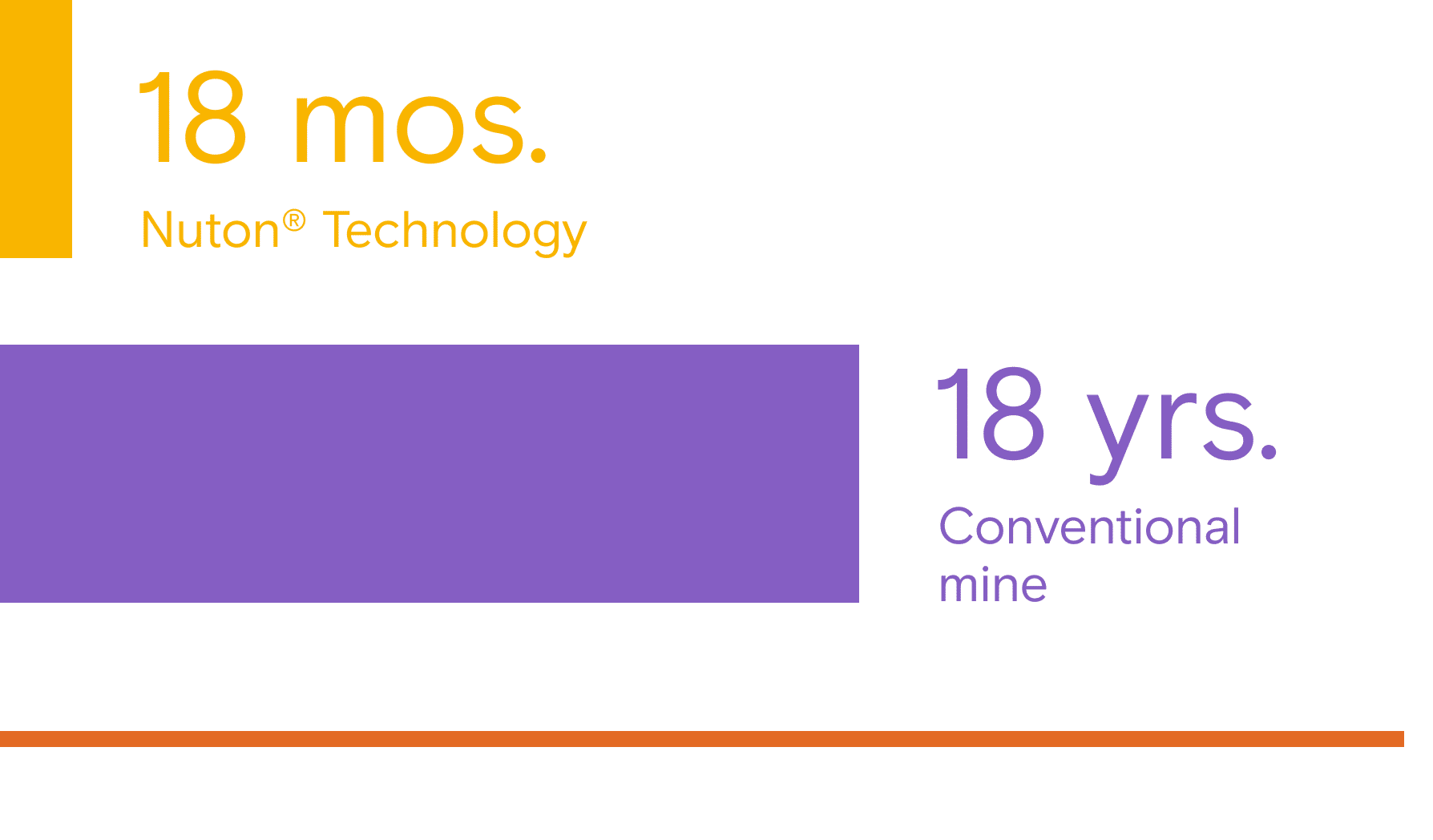
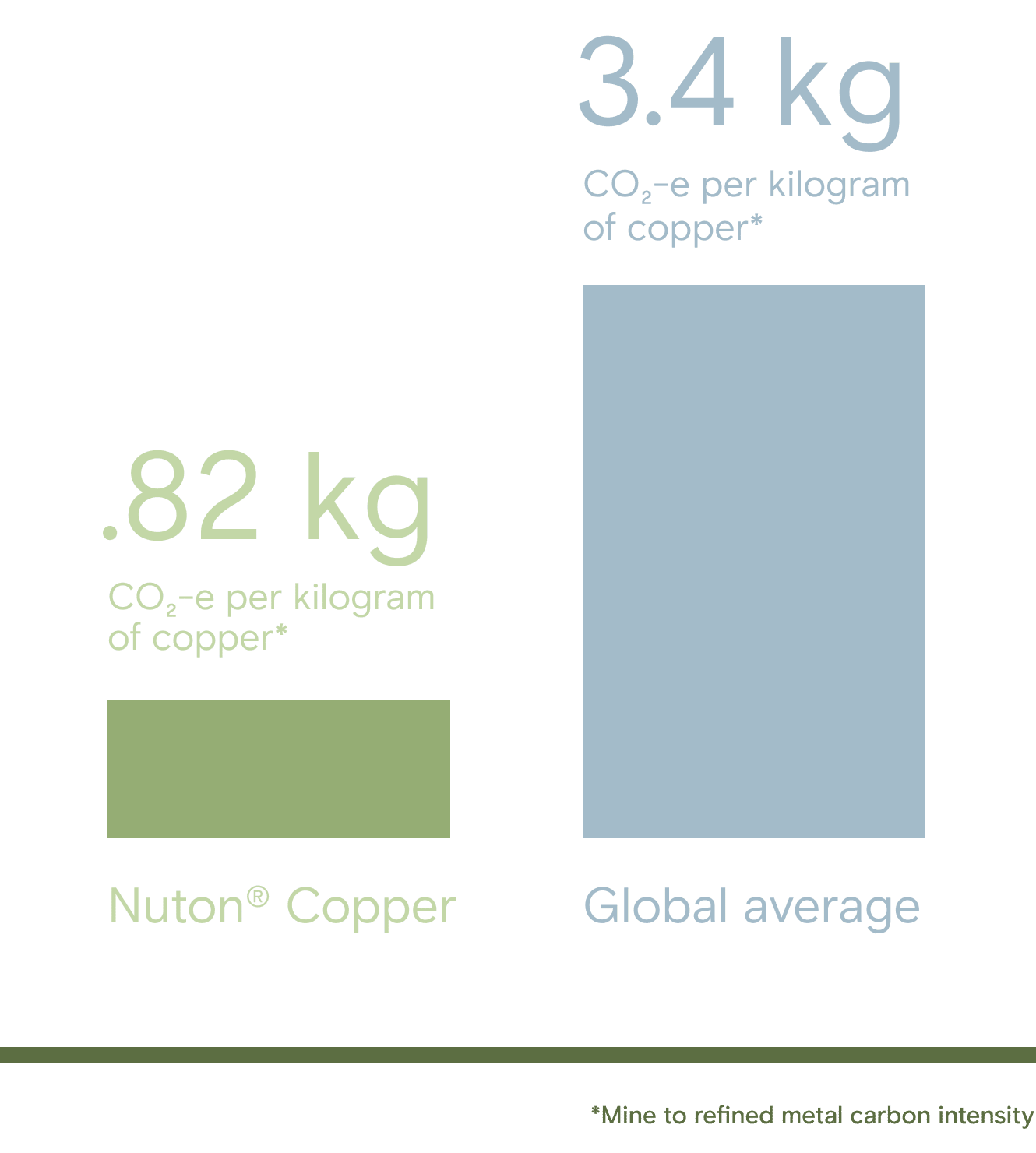

The big picture: closing the US copper supply gap
This milestone will help enable a more resilient domestic copper supply chain – critical for the world’s energy transition, national defense, and advanced manufacturing. With US copper demand projected to grow more than 48% over the next decade, and approximately half of refined copper currently being imported, the Nuton technology provides a pathway to help close the domestic supply gap.
By producing the copper cathode at the mine site, the Nuton process eliminates the need for smelting and refining elsewhere – a major advantage as the US lacks capacity for refining copper. Nuton’s process streamlines the journey from mine to market, reducing the reliance on foreign processing and shortening the supply chain.
The project has already resulted in the sale of approximately 100 tons of copper cathode to North American customers, generating Nuton’s first revenue. The Johnson Camp operation is designed to ramp up toward its capacity of 25 million pounds of finished copper cathode annually.
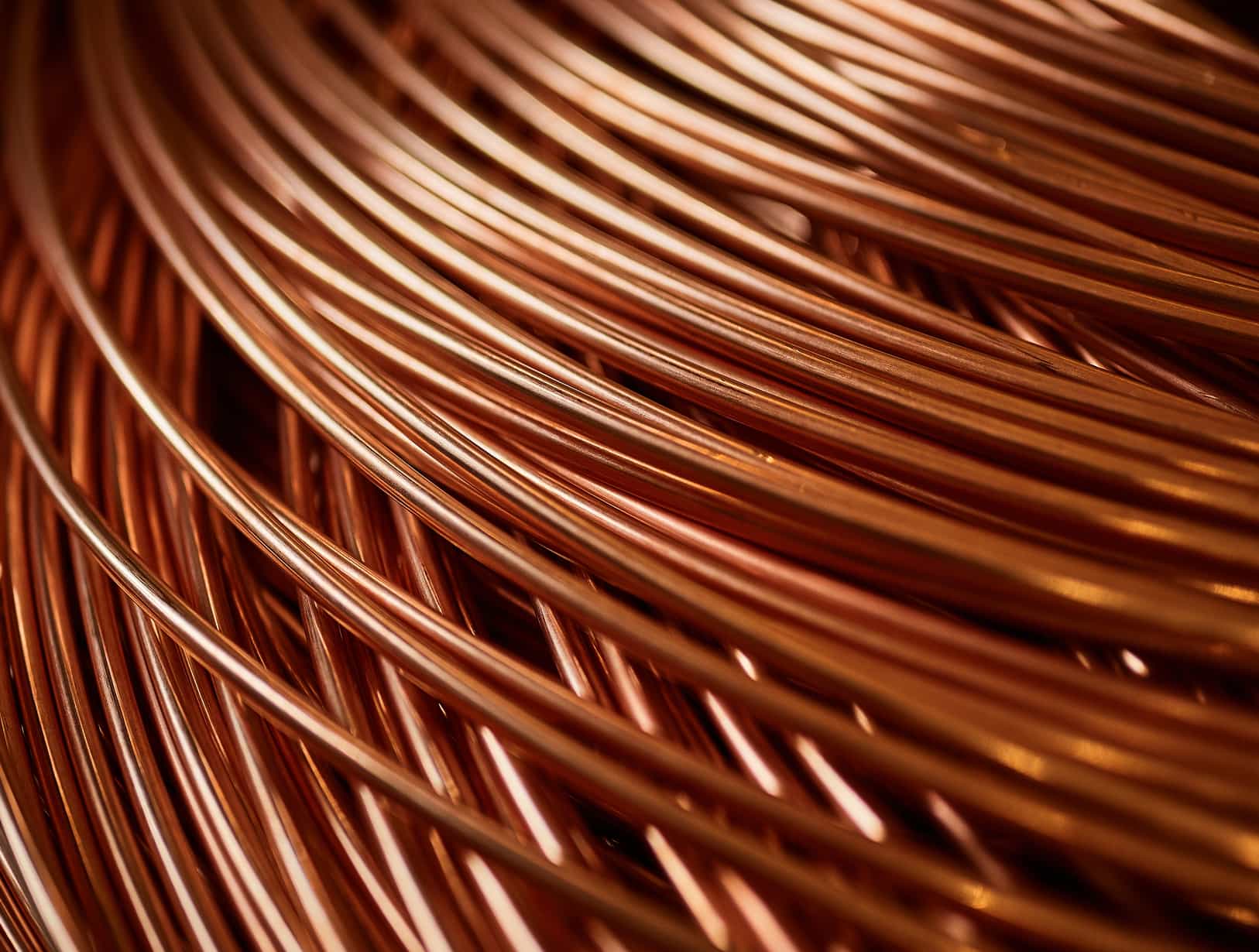
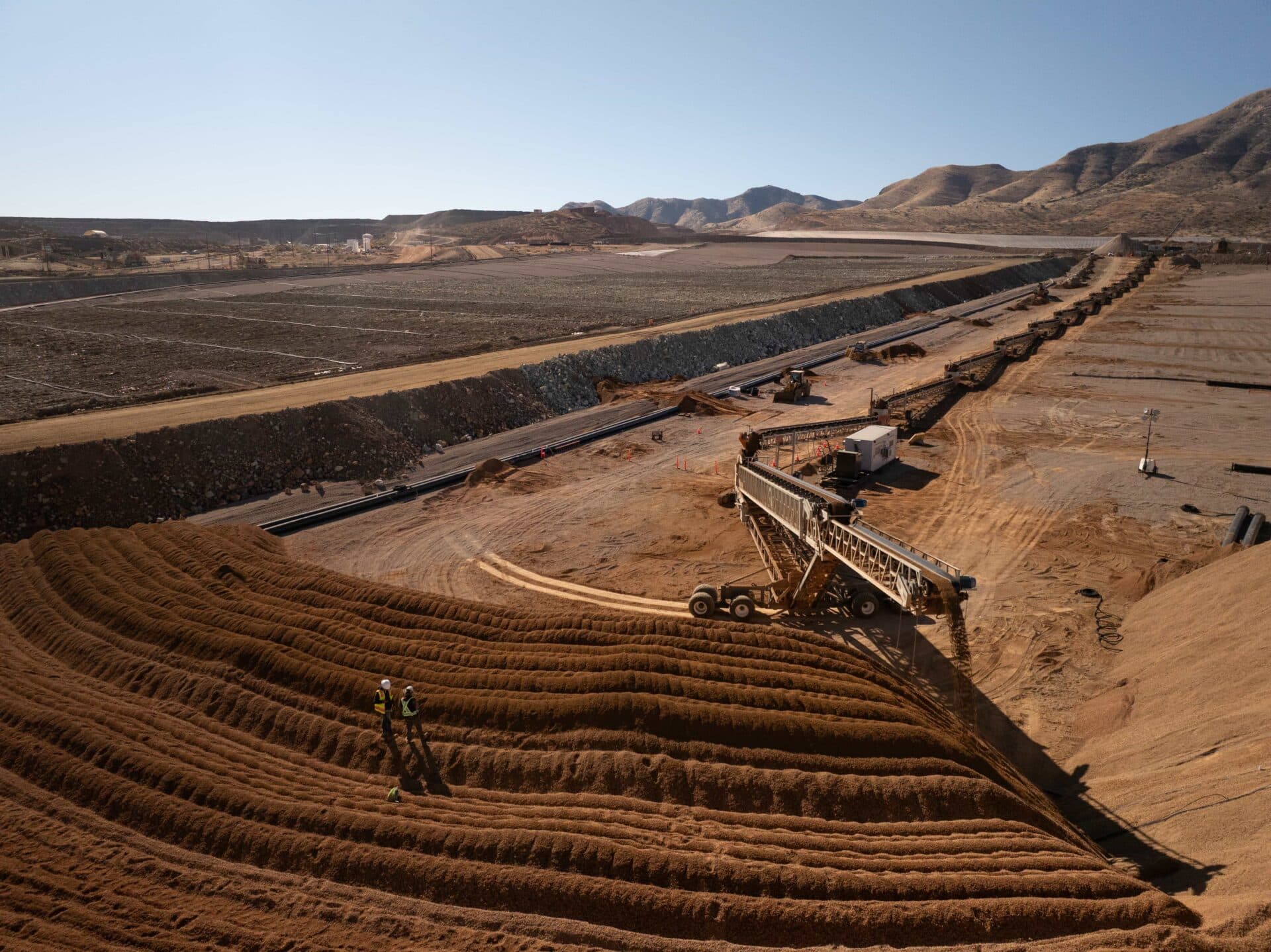
This is just the beginning: validating long-term performance
Nuton’s technology is rapidly scaling, with 11 partnerships across five countries. The next phase at JCM focuses on a critical journey of validating long-term technical performance backed by sustained production.
Rio Tinto has successfully produced the first copper from the Johnson Camp mine in Arizona using its Nuton® Technology, marking a pivotal step forward in the development of this innovative copper processing technology.
After more than 30 years of research and development, the first copper cathode using Rio Tinto’s proprietary bioleaching technology, which relies on microorganisms grown on site, was produced at Gunnison Copper’s Johnson Camp mine last month. The deployment involves the design and delivery of a technology package for a heap leach pad targeting production of approximately 30,000 tonnes of refined copper over a four-year demonstration period. Rio Tinto is engaging with several potential customers in the U.S. to support the domestic copper supply chain.
Rio Tinto Copper Chief Executive Katie Jackson said, “This is a breakthrough achievement for our Nuton technology, which is proving that cleaner, faster, and more efficient copper production is possible at an industrial scale. In an industry where projects typically take about 18 years to move from concept to production, Nuton has now proven its ability to do this in just 18 months.
“Nuton has designed a modular system deployed as a technology package integrating biology, chemistry, engineering, and digital tools, allowing it to be rapidly scaled and tailored to different ore bodies, unlocking resources that have historically been considered uneconomic or challenging. We are actively partnering on projects in North and South America to assess the potential for future deployment at additional sites in the coming years.”
Nuton relies on naturally occurring microorganisms to extract copper from primary sulphide ores, which are traditionally difficult to process. These microbes, grown at large scale in Nuton’s proprietary bioreactors, accelerate the oxidation of minerals in the crushed ore heap, generating heat and enabling copper to dissolve into a leach solution, which is then processed into 99.99% pure copper cathode.
Significantly, processing copper ore with Nuton eliminates the need for concentration, smelting and refining, shortening supply chains and delivering copper cathode at the mine gate. It achieves recovery rates of up to 85% from primary sulphides, the most abundant copper bearing ores in the world.
Nuton can also extend mine life and maximize resource use by extracting value from ores that would otherwise be classified as waste, increasing yield and revenue at both new and existing mines. Its environmental performance is expected to exceed conventional copper processing technologies, with up to 80% less water usage and up to 60% lower carbon emissions than the traditional concentrator route.
At Johnson Camp, Nuton aims to produce copper with the lowest carbon footprint in the U.S. Through the purchase of 134,000 Green-e Energy certified renewable energy certificates, Nuton ensures 100% of the site’s electricity is matched by renewable sources. The copper produced is anticipated to have a mine-to-metal carbon footprint of 0.82-kilogram CO₂-e per kilogram copper, the lowest in the U.S. and substantially lower than the projected 2026 global average of 3.4 kilograms CO₂-e per kilogram among operating copper mines. Additionally, water intensity is anticipated to be 71 litres per kilogram copper, compared to the global average industry estimate of ~130 litres per kilogram of copper production.
Gunnison Copper Chief Executive Officer and President Stephen Twyerould said, “The first production of Nuton copper at Johnson Camp is the culmination of exceptional teamwork between Gunnison Copper and Rio Tinto’s Nuton team. Achieving this level of performance in such a short time frame shows what is possible when innovation, operational excellence, and a shared vision come together. With Nuton copper now entering the U.S. supply chain, this milestone underscores the critical role we can play in strengthening domestic access to cleaner, low-carbon copper.”
While this milestone confirms Nuton’s engineering and operational viability, the next phase will focus on validating long-term technical performance. This includes multi-year testing, independent third-party verification, and internal review by Rio Tinto to ensure consistent recovery rates and environmental performance.
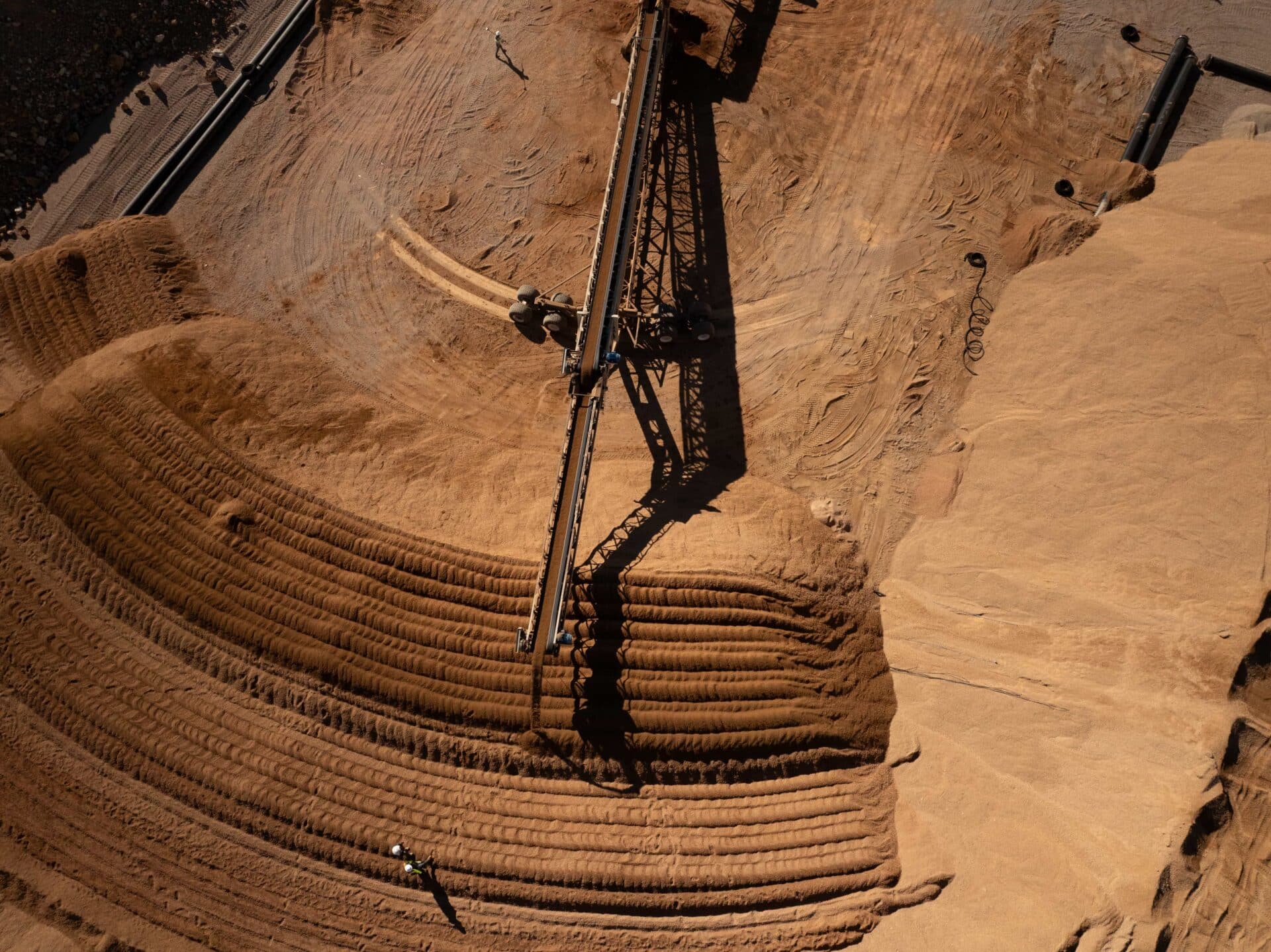


Contacts
Please direct all enquiries to media.enquiries@riotinto.com
| Media Relations, United Kingdom Matthew Klar M +44 7796 630 637 David Outhwaite M +44 7787 597 493 | Media Relations, Australia Matt Chambers M +61 433 525 739 Alyesha Anderson M +61 434 868 118 Rachel Pupazzoni M +61 438 875 469 Bruce Tobin M +61 419 103 454 | Media Relations, Canada Simon Letendre M +1 514 796 4973 Malika Cherry M +1 418 592 7293 Vanessa Damha M +1 514 715 2152 |
| Investor Relations, United Kingdom Rachel Arellano M: +44 7584 609 644 David Ovington M +44 7920 010 978 Laura Brooks M +44 7826 942 797 Weiwei Hu M +44 7825 907 230 | Investor Relations, Australia Tom Gallop M +61 439 353 948 Eddie Gan-Och M +976 95 091 237 | Media Relations, US & Latin America Jesse Riseborough M +1 202 394 9480 |
| Rio Tinto plc 6 St James’s Square London SW1Y 4AD United Kingdom T +44 20 7781 2000 Registered in England No. 719885 | Rio Tinto Limited Level 43, 120 Collins Street Melbourne 3000 Australia T +61 3 9283 3333 Registered in Australia ABN 96 004 458 404 |
VANCOUVER, CANADA (November 24, 2025) – Aldebaran Resources Inc. (“Aldebaran” or the “Company”) (TSX-V: ALDE, OTCQX: ADBRF) is pleased to announce the filing on SEDAR+ of an updated Technical Report and Preliminary Economic Assessment (the “Altar PEA”) on the Altar copper-gold project located in San Juan Province, Argentina, prepared in accordance with National Instrument 43-101 – Standards of Disclosure in Mineral Projects. The Altar PEA has an effective date of September 1, 2025, and was created by SRK Consulting Inc. as lead consultants with Knight Piesold as a subcontractor. The report titled “Preliminary Economic Assessment, Altar Project, San Juan, Argentina” has been filed on the SEDAR+ website at www.sedarplus.ca and will be posted on the Company’s website at www.aldebaranresources.com.
Additionally, the Company announces that Nuton Holdings Ltd., a Rio Tinto venture (“Nuton”), has provided notice of termination of the option to joint venture agreement announced on November 7, 2024, under which Nuton had the right to acquire a 20% interest in the Altar project. Nuton’s decision comes as they are shifting priorities to focus on later-stage projects that could potentially deliver nearer-term production. Despite the termination, Nuton and Aldebaran could still enter a licensing agreement to deploy the Nuton® Technology, proprietary bio-leaching technology, at Altar.
John Black, Chief Executive Officer and Director of Aldebaran, commented: “The PEA demonstrated that the base case concentrator scenario for Altar is a long-life project delivering significant copper, gold, and silver production at attractive cash costs while minimizing upfront capital. With an NPV (8%) of US$2 billion and an IRR of 20.5%, we believe that Altar is an attractive large-scale copper gold project and a very important project for Argentina moving forward. We thank Nuton for their participation in the Altar project and understand that their shift in priorities made continuing with the Altar option agreement challenging. We retain an 80% interest in the project and look forward to advancing it towards a pre-feasibility study with our joint venture partner Sibanye-Stillwater.”
Qualified Person
The scientific and technical data contained in this news release has been reviewed and approved by Dr. Kevin B. Heather, B.Sc. (Hons), M.Sc, Ph.D, FAusIMM, FGS, Chief Geological Officer and director of Aldebaran, who serves as the qualified person (QP) under the definitions of National Instrument 43-101.
ON BEHALF OF THE ALDEBARAN BOARD
(signed) “John Black”
John Black
Chief Executive Officer and Director
Tel: +1 (604) 685-6800
Email: info@aldebaranresources.com
Please click here and subscribe to receive future news releases: https://aldebaranresources.com/contact/subscribe/
For further information, please consult our website at www.aldebaranresources.com or contact:
Ben Cherrington
Manager, Investor Relations
Phone: +1 347 394-2728 or +44 7538 244 208
Email: ben.cherrington@aldebaranresources.com
About Aldebaran Resources Inc.
Aldebaran is a mineral exploration company that was spun out of Regulus Resources Inc. in 2018 and has the same core management team. Aldebaran holds an 80% interest in the Altar copper-gold project in San Juan Province, Argentina. The Altar project hosts multiple porphyry copper-gold deposits with potential for additional discoveries. Altar forms part of a cluster of world-class porphyry copper deposits which includes Los Pelambres (Antofagasta Minerals), El Pachón (Glencore), and Los Azules (McEwen Copper). In November 2024 the Company announced an updated mineral resource estimate for Altar, prepared by Independent Mining Consultants Inc. and based on the drilling completed up to and including the 2023-24 field season (independent technical report prepared by Independent Mining Consultants Inc., Tucson, Arizona, titled “Technical Report, Estimated Mineral Resources, Altar Project, San Juan Province, Argentina”, dated December 31, 2024 – see news release dated November 25, 2024).
Neither the TSX Venture Exchange nor its Regulation Services Provider (as that term is defined in policies of the TSX Venture Exchange) accepts responsibility for the adequacy or accuracy of this release.
Forward-Looking Statements
This news release contains “forward-looking information” or forward-looking statements” within the meaning of Canadian and United States securities legislation. All statements included herein, other than statements of historical fact, including, without limitation, statements relating to the Altar project as a profitable project for the Company, the scale, throughput, resources, projected production and projected profitability of the Altar project, completion of a pre-feasibility study, and projected economics, including NPV, IRR, and cash costs, are forward-looking. Generally, the forward-looking information and forward looking statements can be identified by the use of forward looking terminology such as “plans”, “expects” or “does not expect”, “is expected”, “budget”, “scheduled”, “estimates”, “forecasts”, “intends”, “anticipates” or “does not anticipate”, “will continue” or “believes”, or variations of such words and phrases or state that certain actions, events or results “may”, “could”, “would”, “might” or “will be taken”, “occur” or “be achieved”. The material factors or assumptions used to develop forward looking information or statements are disclosed throughout this news release.
Forward looking information and forward-looking statements, while based on management’s best estimates and assumptions, are subject to known and unknown risks, uncertainties and other factors that may cause the actual results, level of activity, performance or achievements of Aldebaran to be materially different from those expressed or implied by such forward-looking information or forward-looking statements. Although Aldebaran has attempted to identify important factors that could cause actual results to differ materially from those contained in forward-looking information and forward-looking statements, there may be other factors that cause results not to be as anticipated, estimated or intended. There can be no assurance that such information or statements will prove to be accurate, as actual results and future events could differ materially from those anticipated in such information or statements. The Company has and continues to disclose in its Management’s Discussion and Analysis and other publicly filed documents, changes to material factors or assumptions underlying the forward-looking information and forward-looking statements and to the validity of the information, in the period the changes occur. The forward-looking statements and forward-looking information are made as of the date hereof and Aldebaran disclaims any obligation to update any such factors or to publicly announce the result of any revisions to any of the forward-looking statements or forward-looking information contained herein to reflect future results. Accordingly, readers should not place undue reliance on forward-looking statements and information.
The mining world just recognized a radical shift in copper production. Nuton earned Mining Magazine‘s 2025 Technology & Innovation Award, validating its pioneering bioleaching process and its immediate, positive impact on the copper sector’s environmental profile.
The award acknowledges Nuton’s superior performance, rapid on-site deployment, and advanced bioleaching technology. The award judges declare, “In a world of falling grades, a process that can make copper sulphides economically attractive is a massive achievement.”
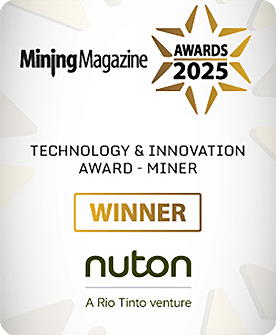
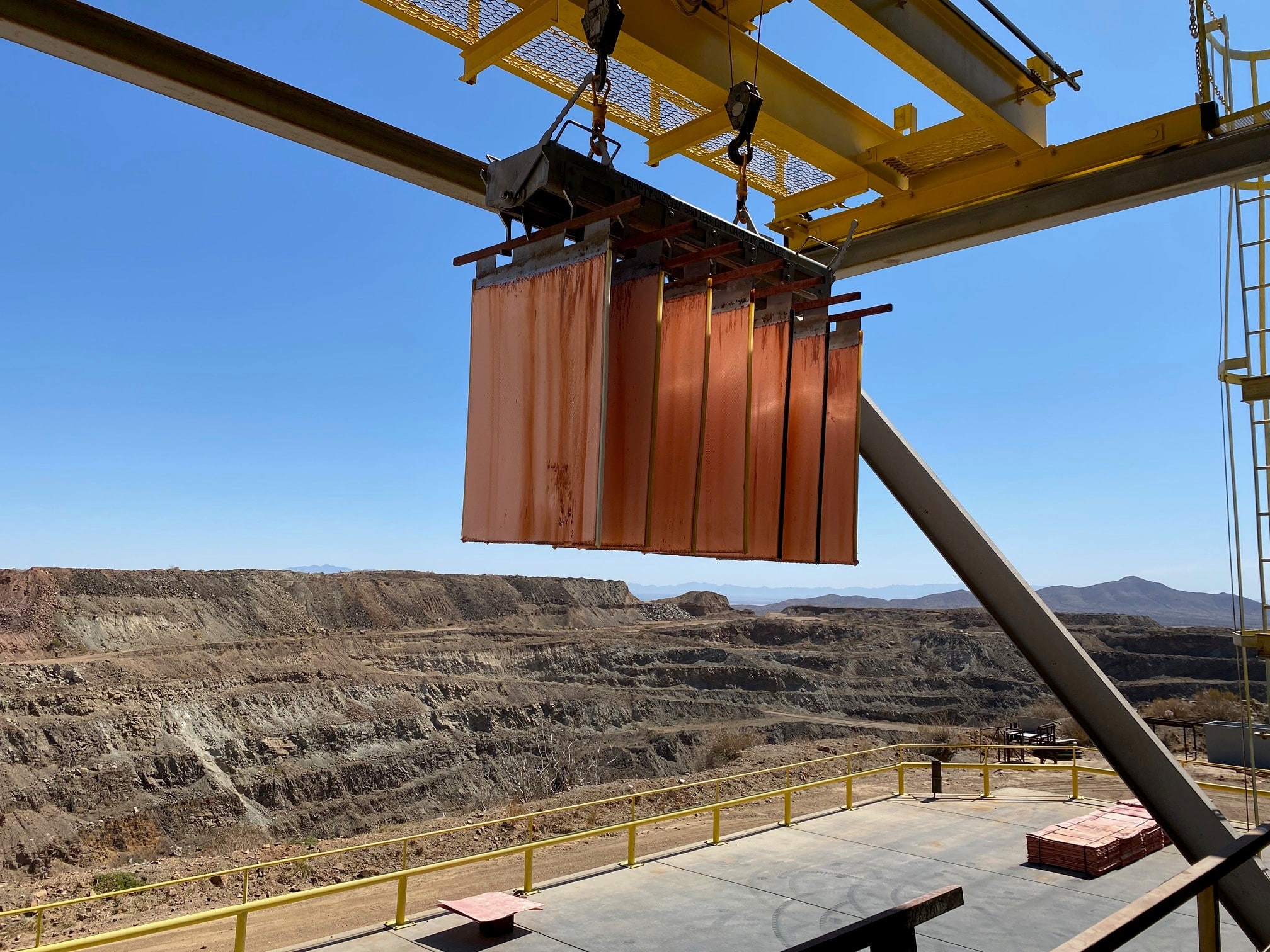
In celebration of the Mining Award for Technology & Innovation award, Nuton CEO Adam Burley sat down with Mining Magazine’s Dominic Hale to discuss the evolution of copper production. Watch the full conversation below.
The annual Mining Magazine Awards recognize outstanding achievements, projects and technologies. They cover various categories such as Mineral Processing, Drill & Blast, Bulk Handling and Net Zero Achievement, honoring companies and individuals for their innovation, efficiency and safety advancements.
VANCOUVER, CANADA (October 30, 2025) – Aldebaran Resources Inc. (“Aldebaran” or the “Company”) (TSX-V: ALDE, OTCQX: ADBRF) is pleased to announce the results of a Preliminary Economic Assessment (“PEA”), prepared in accordance with National Instrument 43-101 standards, for the Altar copper-gold project located in San Juan, Argentina. The base case scenario utilizes a 60,000 tonnes per day (“tpd”) concentrator, processing mineralized material from both open pit and underground sources. The results of the PEA are reported on a 100% basis, while Aldebaran owns an 80% interest in the project, with the remaining 20% held by Sibanye-Stillwater Ltd.
All dollar amounts referenced herein are in US dollars unless otherwise noted.
HIGHLIGHTS
Long life operation with significant production:
- 48-year mine life, including 3 years of construction
- First 20 years1: Average annual production of 121,445 tonnes copper equivalent2 (“CuEq”)
- 108,579 tonnes copper (“Cu”), 43,199 ounces of gold (“Au”), and 570,217 ounces of silver (“Ag”)
- First 30 years1: Average annual production of 116,294 tonnes CuEq
- 105,897 tonnes Cu, 33,866 ounces of Au, and 557,239 ounces of Ag
- LOM: Average annual production of 101,413 tonnes CuEq
- 92,891 tonnes Cu, 27,020 ounces of Au, and 525,192 ounces of Ag
Robust economics with leverage to commodity prices:
- Using base-case metal prices of $4.35/lb Cu, $2,500/oz Au, and $27/oz Ag, the project has an after-tax NPV (8%) of $2.0 billion, an IRR of 20.5% and a payback period of 4 years
- Total LOM gross revenue of $44.7 billion (before TC/RCs, payabilities and transport) and total LOM free cash flow of $10.7 billion
- Using spot prices of $5.00/lb Cu, $3,963/oz Au, and $47/oz Ag, the project has an after-tax NPV (8%) of $3.34 billion and an IRR of 28.0%4
Attractive capital intensity:
- Initial capex for the project is $1.59 billion
- Upfront capital is minimized by taking a staged approach to the tailings storage facility and underground construction
- Capital intensity of $15,713/t of average annual CuEq metal produced3
- NPV @ 8% / Initial Capex ratio of 1.27x
Competitive cost profile:
- Cash Costs (C1) of $1.71/lb payable Cu for the first 20 years1, $1.87/lb payable Cu for the first 30 years1, and $2.02/lb payable Cu for the LOM
- All in Sustaining Costs (“AISC”) of $2.25/lb payable Cu for the first 20 years1, $2.42/lb payable Cu for the first 30 years1, and $2.59/lb payable Cu for the LOM
Combined Open Pit and Underground Operation:
- Production from the open pit pays back the initial capital, while development of the underground is ongoing
- Underground mining pulls forward better grade mineralization earlier in the mine life, to increase production and generate cash flow
- ~80% of the resources (by tonnage) in the mine plan are categorized as Measured and Indicated, with the remaining ~20% categorized as Inferred
John Black, Chief Executive Officer of Aldebaran, commented: “This PEA confirms that the Altar project has the potential to become a long-life, high-quality copper operation capable of generating substantial production and cash flow. Our objective was to define a mine plan that delivers a minimum of 100,000 tonnes of CuEq per year, while maintaining a compact operational footprint and a disciplined approach to capital. The results of this study clearly achieve those objectives and demonstrate that Altar is a technically and economically robust project. This PEA represents a major milestone for the Company and provides the foundation for our upcoming application for inclusion under Argentina’s RIGI investment framework. With the political environment in Argentina shifting toward pro-business and pro-development policies—as underscored by the recent mid-term election results—the timing for advancing a project of Altar’s scale could not be better. The country is positioning itself to emerge as a significant copper producer at a time when global demand for the metal continues to rise. In addition to the base case concentrator scenario, our collaboration with Nuton, a Rio Tinto venture, demonstrates Nuton® Technology as a potentially viable processing alternative at Altar. Utilizing Nuton® Technology, life-of-mine capital expenditure and operating costs were reduced, leading to higher life-of-mine free cash flow. When you combine the economic results with the ESG benefits of Nuton’s sulphide leaching technology, the Nuton case is quite compelling and warrants further evaluation. The next 12 to 18 months will be transformative for the Company, with multiple key catalysts—including a resource update, completion of the PFS, and the proposed Centauri Minerals spin-out—positioning us to unlock significant value for our shareholders.”
Kevin B. Heather, Chief Geological Officer of Aldebaran, commented: “The PEA represents a significant milestone for the Altar project. In addition to achieving the goals John stated above, we were also focused on maximizing NPV and IRR, hence we elected to move forward with a mine plan that included a combination of open-pit and underground block caving. The block cave, commencing production after the open pit pays back the initial capital, allows us to pull forward higher-grade material in the mine plan and to maintain constant CuEq production numbers, while keeping throughput at 60,000 tpd. Moreover, it keeps the overall footprint of the operation smaller, which is a key consideration for development projects. Our approach to capital expenditures was to stage capital outlays where possible, to ensure initial capital expenditures were kept manageable. Where possible, capital was paid out of cash flow to present a more prudent and attractive development opportunity. We will now begin to shift our focus to the PFS, which will be the next step in de-risking the Altar project. To that end, our 2025/2026 field program is now underway, with most of the work focused on collecting the additional data necessary for the upcoming PFS. This includes additional infill drilling, geotechnical drilling, lab-based geotechnical stress and strain test work, Acid Based Accounting (ABA) test work, environmental monitoring, water wells, water balance studies, community engagement, and more. While this work is ongoing, we will also be exploring several opportunities that we have identified that could potentially unlock additional value from the Altar Project.”
PEA Overview
When available, readers are encouraged to read the PEA in the Company’s technical report (“Technical Report”) prepared in accordance with National Instrument 43-101 – Standards of Disclosure for Mineral Projects (“43-101”) in its entirety, including all qualifications, assumptions and exclusions that relate to the PEA and mineral resource model. The Technical Report is intended to be read as a whole, and sections should not be read or relied upon out of context.
The PEA envisions a combination of open-pit and underground mining, followed by processing via a conventional copper flotation circuit having a nameplate processing capacity of 60,000 tonnes per day. This results in a mine life of 48 years with an average annual production of 102,742 CuEq tonnes for LOM, 116,539 tonnes CuEq for the first 30 years, and 121,748 CuEq tonnes for the first 20 years. Table 1 presents key operating and financial highlights from the PEA, using base study case assumptions of $4.35/lb Cu, $2,500/oz Au and $27/oz Ag. Figure 1 displays annual CuEq production for the LOM, while Figure 2 displays projected cash flows.
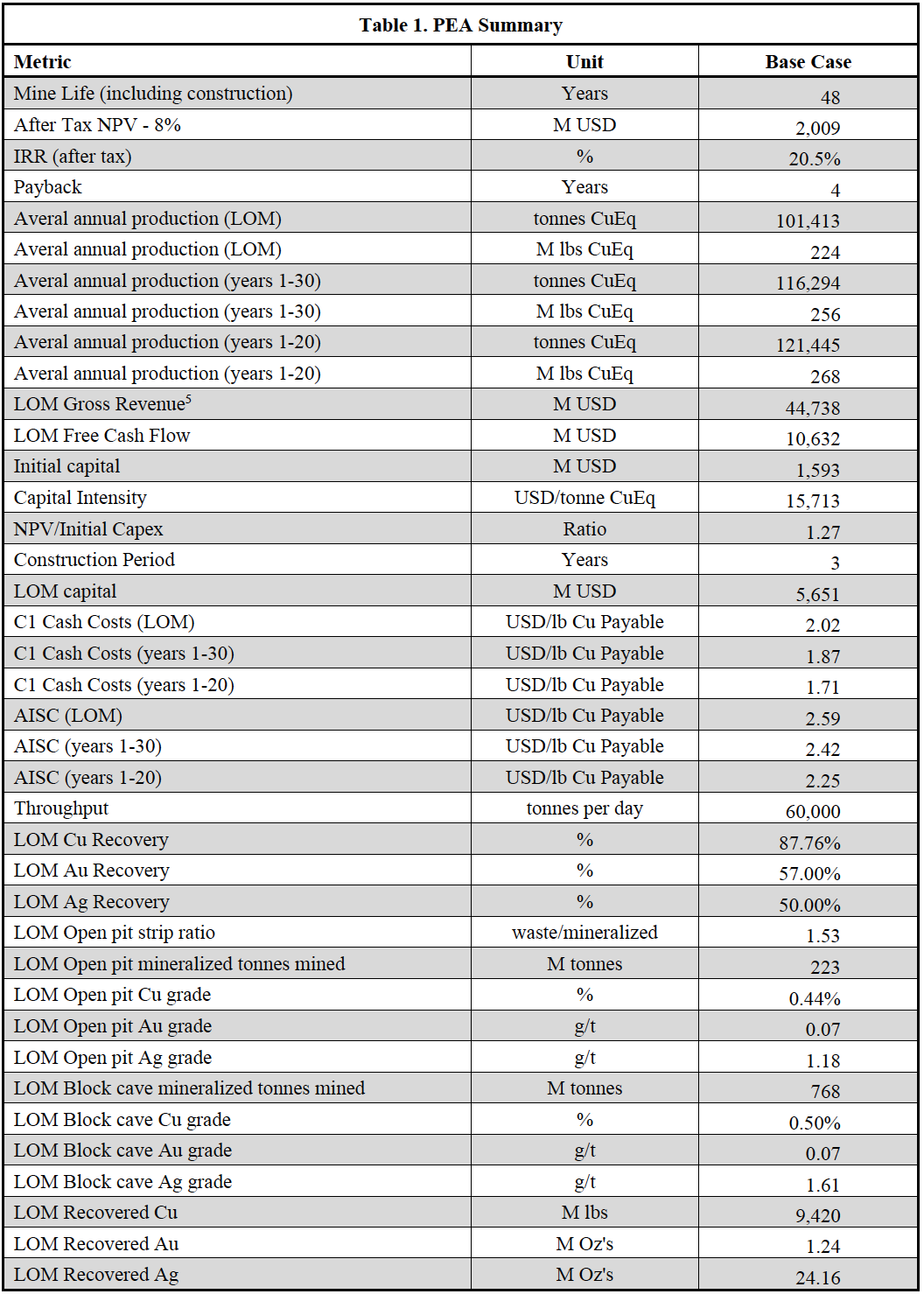
Figure 1 – LOM CuEq Production and C1 Cash Costs
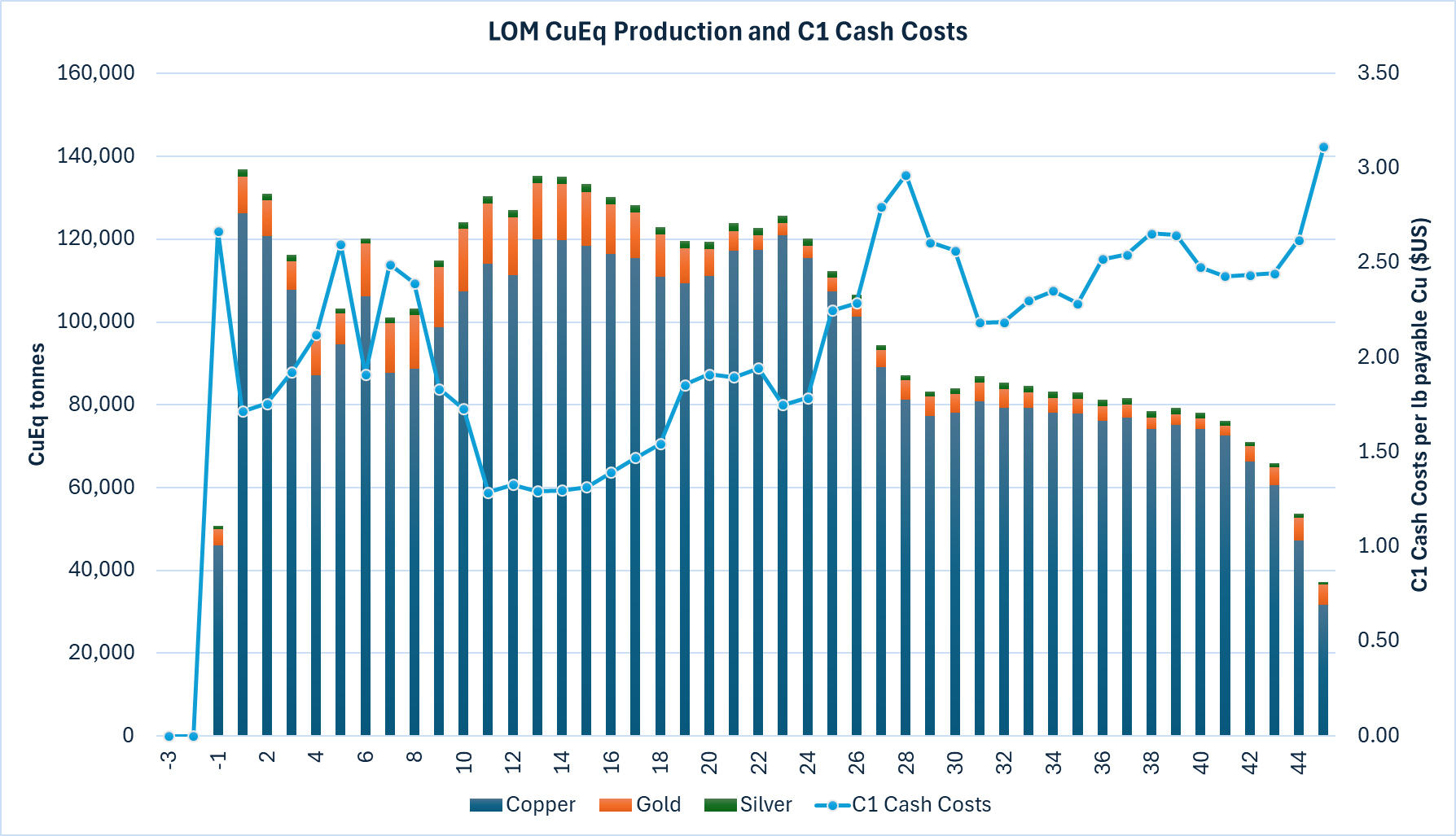
Figure 2 – Project Cash Flows
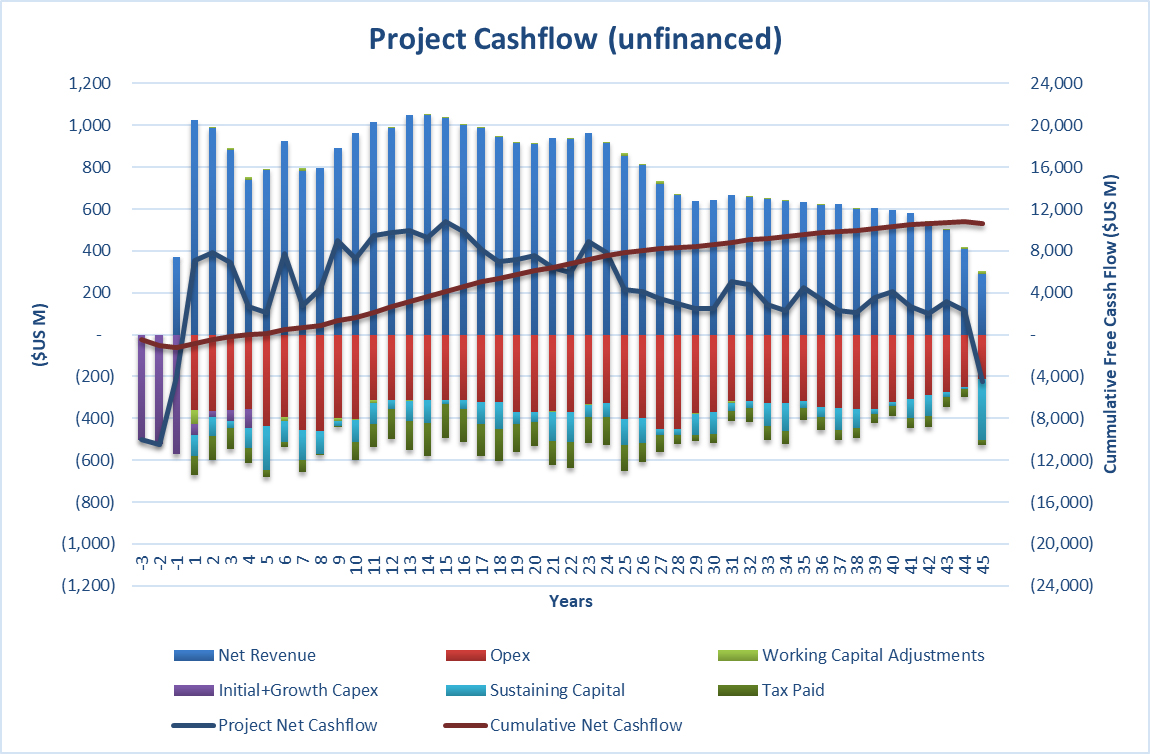
Mineral Resource Estimate
On November 25, 2024, the Company announced an updated mineral resource estimate (“MRE”) for the Altar project (see Table 2). The PEA is based on the MRE; however, the PEA production profile is based on a subset of the MRE, utilizing different metal prices, operating costs, and mining methods.
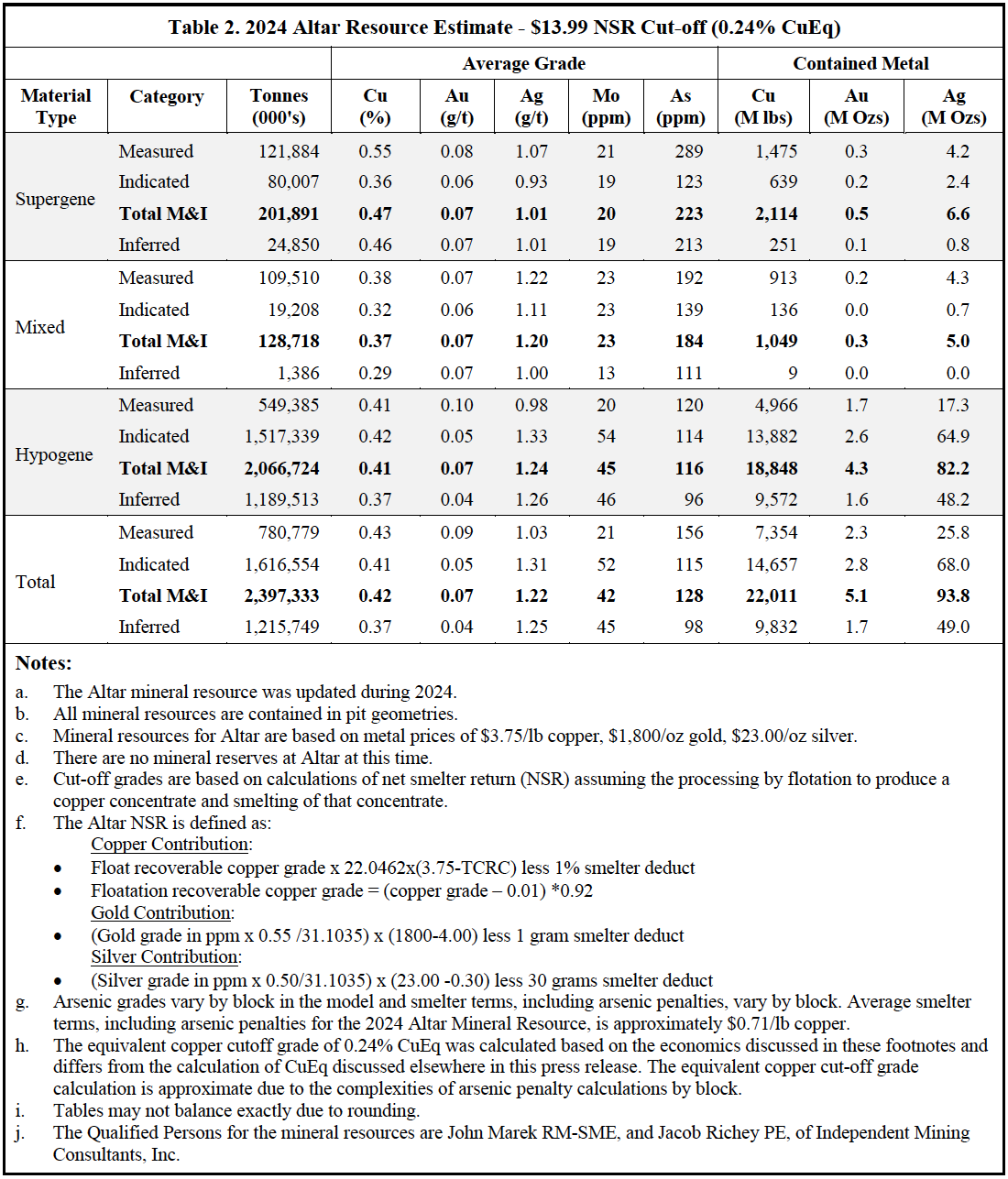
Mining
The proposed mining method is divided into open-pit mining for the near-surface part of the deposit and underground caving for the deeper parts. The open pit will use well-known truck and shovel operations with 12.5-m bench intervals. Haul trucks will be used for hauling mineralized material to the crushing plant and long-term stockpile facilities. Waste rock will be hauled to the closest waste rock storage facility. Underground operations will handle material in bulk using well established block caving methods. Open-pit mining will occur during the first 9 years of operation (in the Altar Central area), while underground development is underway. The mining profile for the project can be seen in Figure 3.
Open pit mining operations will use a smaller-scale equipment fleet that includes 8 m3 hydraulic excavators and 100t capacity SANY haul trucks to allow for narrower bench phases and haul roads, steeper pit slopes, which will facilitate getting into the better-grade, highest-margin mineralization sooner. Underground block cave mining will occur in three areas: Altar East, Altar United, and Altar Central (beneath the open pit). Each underground cave is divided into two lifts, an upper and lower, which will be sequenced as follows: Altar East Upper, Altar United Upper, Altar Central Upper, Altar East Lower, Altar United Lower and Altar Central Lower. Underground access to the block caving mining areas will be through a portal and conveyor drift from the south of the proposed pit (twin declines). To develop the first block cave lift at Altar East, two 3000 m declines are required plus associated development beneath the cave lift.
Figure 3. Mining profile for the LOM
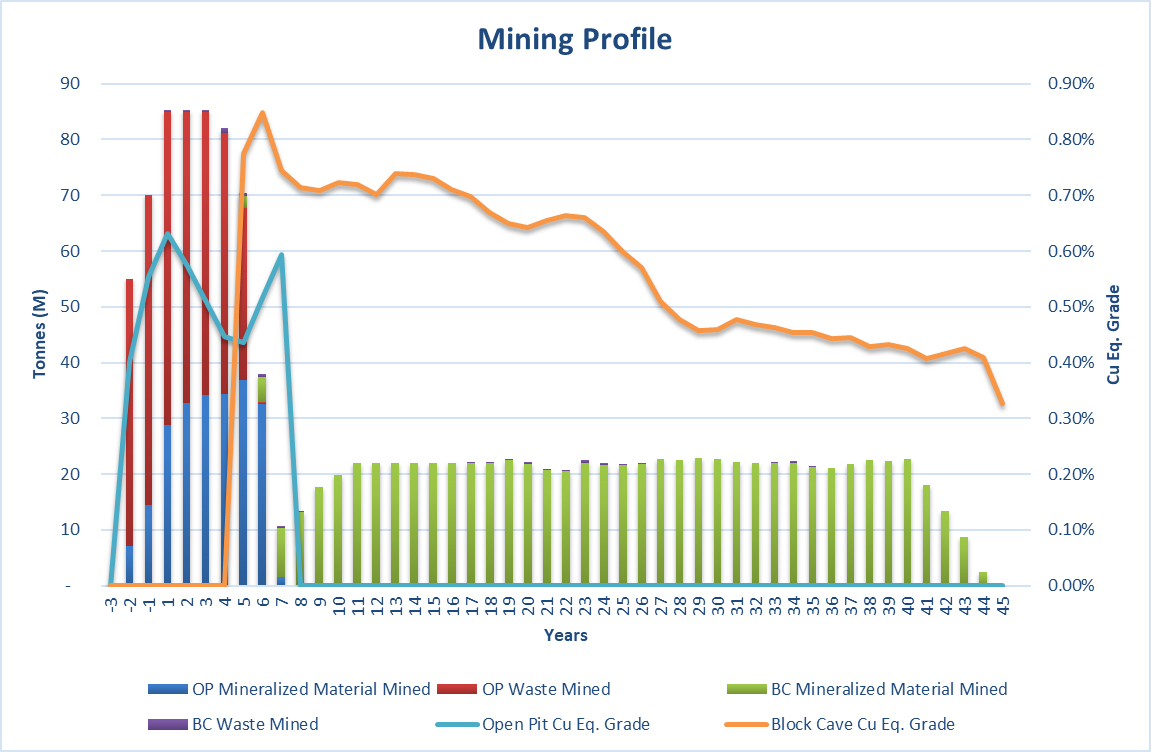
Processing
Extensive metallurgical test work has demonstrated that the contained copper and gold can be effectively recovered in a traditional flotation concentrator that would produce a single gold-bearing copper concentrate using industry-accepted technologies. The flowsheet includes primary crushing followed by grinding in a SAG (semi-autogenous grinding) mill/ball mill grinding circuit, rougher flotation, regrinding of the rougher concentrate and three stages of cleaner flotation. The concentrator would be constructed with a capacity to process 60,000 tpd and operated on a 365 day/year, 24 hour/day schedule. A simplified process flowsheet can be seen in Figure 4. LOM average recoveries for Cu, Au and Ag are 87.76%, 57% and 50% respectively. The grade of the concentrate produced is 26% for the LOM. Arsenic in the concentrate is expected to range from 0.5% to 2.2%. Aldebaran hired the CRU Group, a global leader in commodity research and market analysis, to complete a study analyzing the placement of arsenic-bearing concentrates into the marketplace, which showed that blending capacity for arsenic-bearing copper concentrates worldwide has increased materially in recent years, and penalties paid for arsenic-bearing concentrates have decreased substantially. The PEA utilizes CRU’s view on arsenic penalties.
Figure 4. Processing Circuit
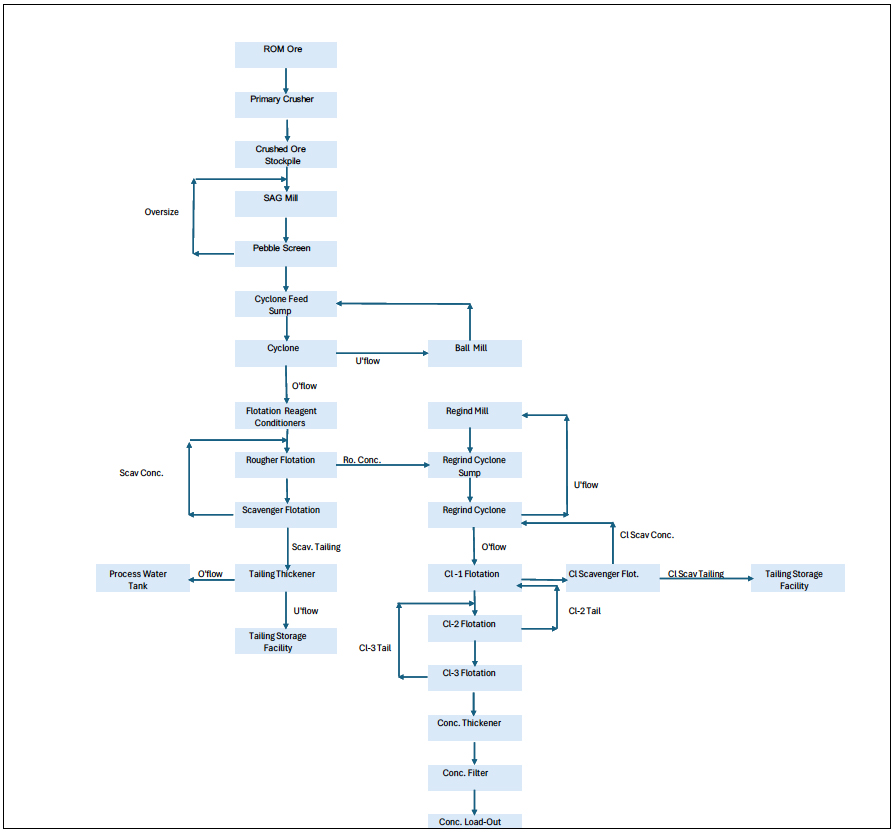
Capital and Operating Costs
The capital cost estimate prepared for the PEA includes an installation cost associated with the site infrastructure, open pit mine and concentrator plant, a growth capital associated with the installation of the block caving underground mining operation, and the sustaining capital associated with the production plan. The LOM summary of capital is presented in Table 3, while the capital profile for the LOM is presented in Figure 5.
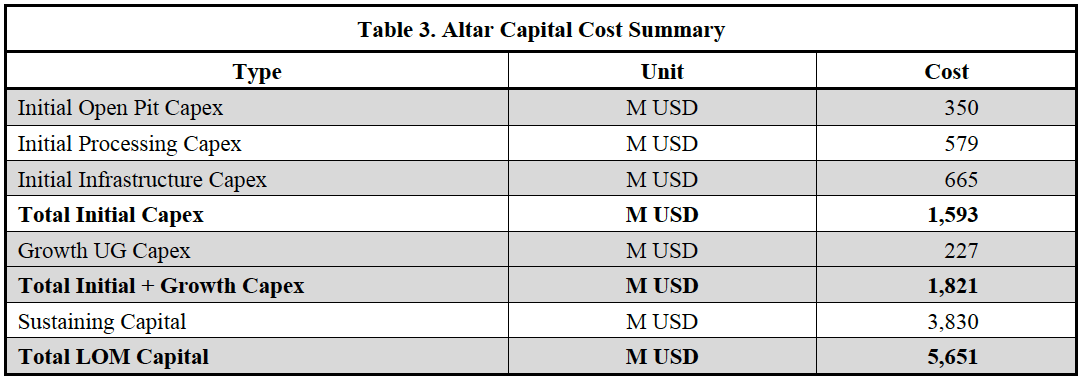
Figure 5. Capital Profile for the LOM
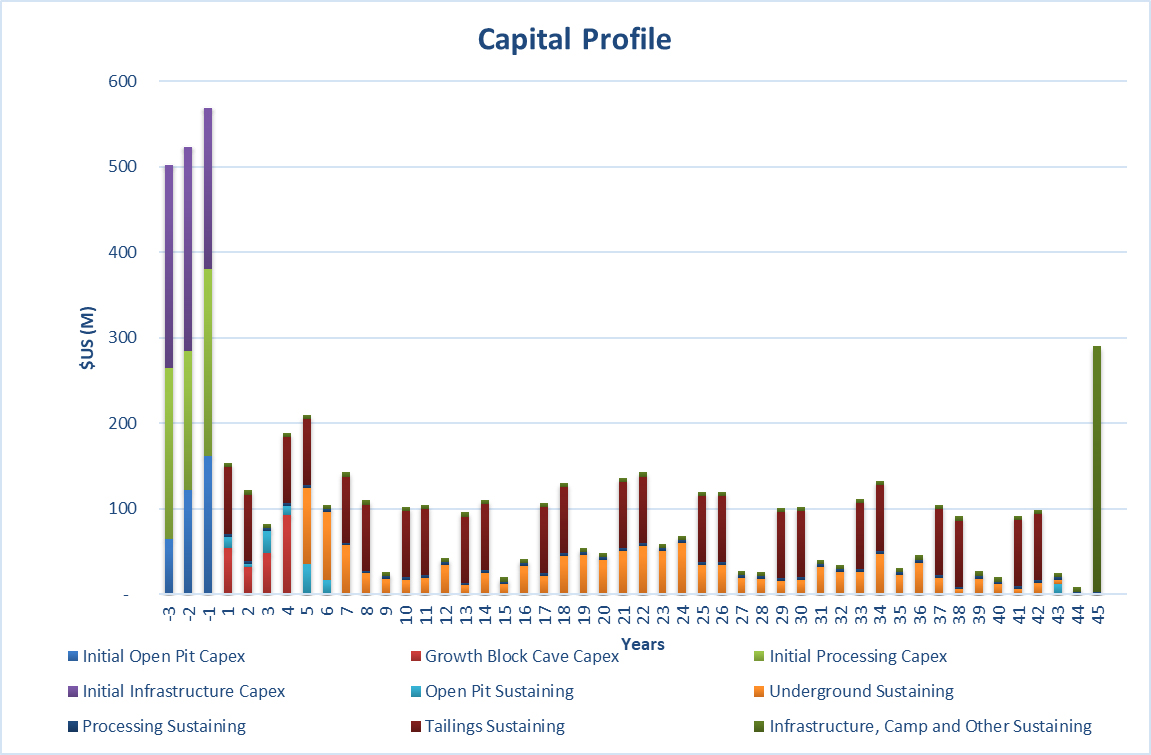
Operating costs were estimated for the open pit mining operation, block caving mining operation, the concentrator processing operation, and G&A. A summary of the estimated operating costs is presented in Table 4. The buildup of LOM C1 cash costs and AISC can be found in Tables 5 and 6, while operating costs by year can be found in Figure 6.

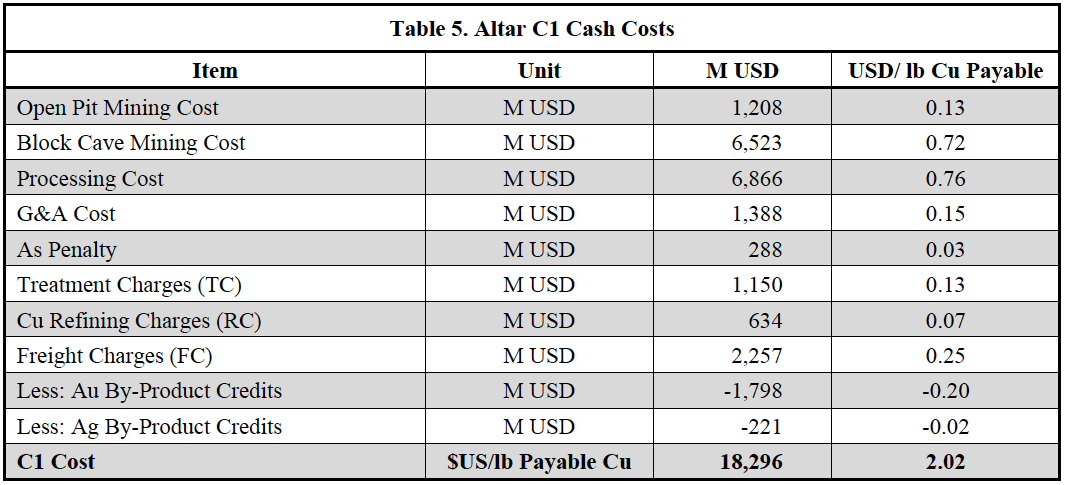
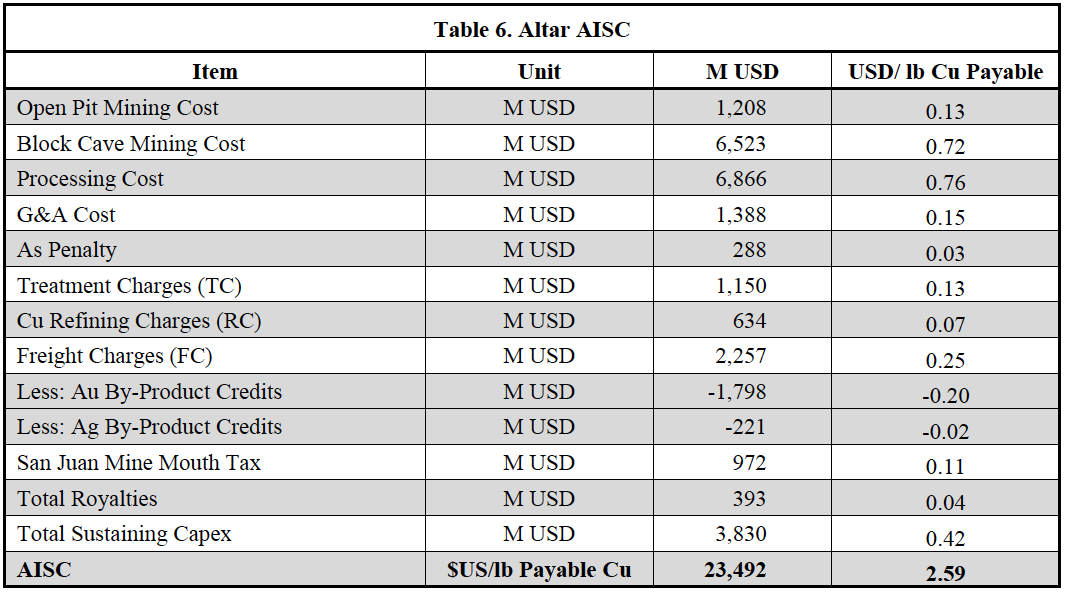
Figure 6. Operating Cost by Year
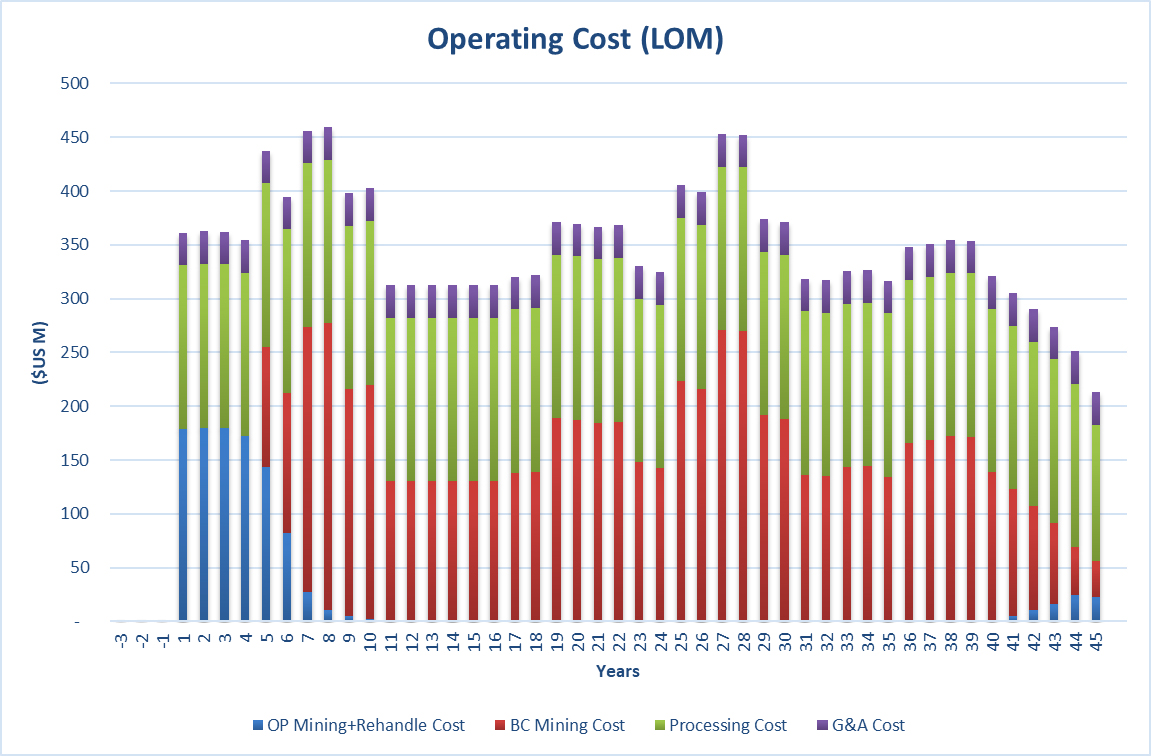
Infrastructure
The Altar project includes on-site infrastructure such as earthworks development, crushing and process plant facilities as well as ancillary buildings such as camp, warehouses and workshops, on-site roads, water management systems, and site electrical power facilities.
Off-site infrastructure includes a site access road, plant roads, water supply, power supply (power transmission line), two waste rock storage areas, the tailings storage facility, and surface water management structures.
Water use for the project assumes use of surface runoff water, pit dewatering wells, water supply wells within 25 km from the concentrator, with additional water supplied from surface sources.
Nuton, a Rio Tinto venture, Scenario
On November 7, 2024, Aldebaran announced that it had entered an agreement with Nuton Holdings ltd. (“Nuton”), whereby Aldebaran would grant Nuton the option to acquire a 20% stake in the Altar project (see Company press release dated November 7, 2024). As part of that agreement, Aldebaran agreed to include a case in the PEA (“Nuton Case”) utilizing the Nuton® Technology, a suite of proprietary sulphide leaching technologies, as a potential alternative to the base case concentrator scenario reported above (“Base Case”). Nuton® Technology provides the potential to leach both primary and secondary sulphides, providing an alternative processing option for the Altar project. In addition, the Nuton Case provides significant other benefits, such as eliminating the need for a tailings dam, providing a smaller environmental footprint, lower overall energy consumption and lower water consumption than conventional sulphide mineralization treatment processes. Moreover, producing copper cathode on site would eliminate downstream treatment and refining costs, deleterious elements’ penalties, simplify logistics and would provide a finished product at site saleable to the market.
As a result of the work completed in the Phase 1 Nuton® Technology test work program (see Company press release dated November 7, 2024, for details), Nuton has estimated ultimate copper extraction and copper recovery after a 450-day leach cycle for each material type at Altar. The results of this analysis estimate copper extraction from hypogene, mixed and supergene material at 86%, 88% and 91%, respectively. Nuton applies a discount factor of 92% to allow for inherent inefficiencies in the scale up to a commercial heap leach and has, therefore, estimated copper recoveries from hypogene, mixed and supergene material at 79%, 81% and 84%, respectively.
The Nuton Case in the PEA utilizes the same mine plan as the Base Case, due to the use of an overall elevated cutoff grade for both cases; however, it utilizes Nuton® Technology, a bio-leach heap leaching process targeting the leaching of primary and secondary copper sulfide minerals and has been designed to process 60,000 tpd, matching the Base Case throughput. Material will be crushed and processed using a conventional lined heap leach pad and combined with a standard SX/EW facility will produce saleable copper cathode onsite. Aldebaran currently does not have a commercial agreement with Nuton to deploy Nuton® Technology at Altar and there is no guarantee an agreement will come to fruition. For comparative purposes, the Nuton Case does not include project costs associated with licensing and Nuton® Technology services at the Altar Project.
To demonstrate the Nuton Case, the variance percentage relative to the Base Case is included here for selected key production and financial metrics. The results of the Nuton Case can be found in Table 7. Measurable contributors to capital spend include a Tailings Storage Facility (TSF) for the Base Case and a Heap Leach Pad (HLP) for the Nuton Case. The Nuton case shows higher initial capital requirements due to the need for more infrastructure from the start-up (e.g. full-sized ponds) compared to a TSF. However, LOM capex in the Nuton Case is lower, as TSF requires higher sustaining capex to reach final capacity. Additionally, at this time, precious metals such as gold and silver cannot be recovered with Nuton® Technology, whereas they are recovered in the Base Case. Timing of capital and revenue from copper equivalent reduces the NPV for the Nuton Case, but lower total capital and lower operating C1 and AISC costs allow for a higher Free Cash Flow in the Nuton Case.
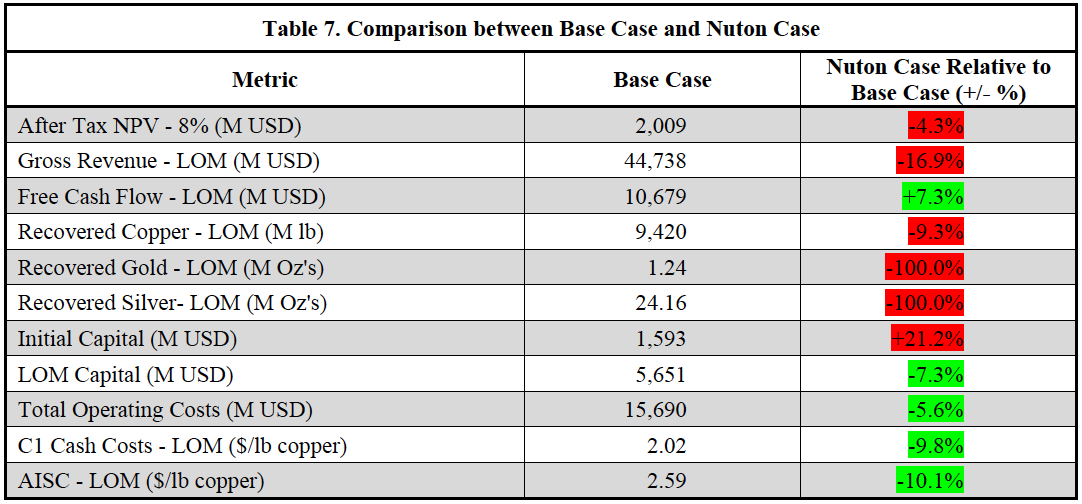
Green represents metrics where the Nuton case improved over the base case whereas red represents metrics where the base case was more attractive than the Nuton case
Opportunities
Several opportunities to potentially unlock additional value remain to be evaluated, including:
- Installation of a molybdenum circuit in the later years of the mine when higher-grade molybdenum is encountered in the lower block caves
- Additional metallurgy to potentially improve copper recoveries
- Combined concentrator and Nuton® Technology scenario
- Processing of concentrate on-site rather than shipping to a smelter
- Filtered tailings storage
- Producing a pyrite concentrate from the pyrite-rich waste rock, that could be used in the Nuton Case
- Upsizing the daily production rate and copper output with better metal prices
Next Steps
- The 2025/2026 field season is underway, with four drill rigs currently being mobilized to site
- Additional infill drilling to convert inferred resources to the measured and indicated categories
- Preparation to apply for inclusion under Argentina’s RIGI benefits
- Produce an updated mineral resource estimate based on the infill drilling completed in 2024-2025 and the to-be-completed 2025-2026 infill drilling (resource conversion)
- Geotechnical drilling within the PEA open pit and underground block caves
- Geotechnical drilling within the PEA tailings storage facility
- Lab-based geotechnical stress and strain test work
- Acid Based Accounting (ABA) test work
- Drilling additional water wells and conducting additional pump tests for water balance studies
- Continue environmental monitoring studies
Study Notes
Aldebaran retained SRK Consulting Inc. as lead consultants, with Knight Piesold as a subcontractor.
The PEA is preliminary in nature, as it includes Inferred Mineral Resources that are considered too speculative geologically to have the economic considerations applied to them that would enable them to be categorized as Mineral Reserves, and there is no certainty that the PEA will be realized. Mineral Resources that are not Mineral Reserves and do not have demonstrated economic viability.
Webinar
For more context, please join the Company in a live event on Friday, October 31 at 11:00 am EST / 8:00 am PDT.
Click here to register: https://6ix.com/event/aldebaran-resources-presents-pea-results.
Qualified Person
The scientific and technical data contained in this news release has been reviewed and approved by Dr. Kevin B. Heather, B.Sc. (Hons), M.Sc, Ph.D, FAusIMM, FGS, Chief Geological Officer and director of Aldebaran, who serves as the qualified person (QP) under the definitions of National Instrument 43-101.
Notes
- Assumes commercial production begins in year 1 after 3 years of construction. 20- and 30-year averages calculated starting in year 1.
- CuEq calculated in the PEA study using $4.35/lb Cu, $2,500/oz Au and $27/oz Ag and is reported utilizing recoveries of 87.76% for Cu, 57% for Au, and 50% for Ag.
- Capital intensity calculated as initial capex divided by LOM average annual CuEq production.
- LME copper price, gold and silver price as of market close on October 27, 2025. The NPV calculation using spot prices was not part of the PEA report and was calculated by Aldebaran using the financial model provided by SRK.
- Before TC/RCs, payabilities and transport.
ON BEHALF OF THE ALDEBARAN BOARD
(signed) “John Black”
John Black
Chief Executive Officer and Director
Tel: +1 (604) 685-6800
Email: info@aldebaranresources.com
Please click here and subscribe to receive future news releases: https://aldebaranresources.com/contact/subscribe/
For further information, please consult our website at www.aldebaranresources.com or contact:
Ben Cherrington
Manager, Investor Relations
Phone: +1 347 394-2728 or +44 7538 244 208
Email: ben.cherrington@aldebaranresources.com
About Aldebaran Resources Inc.
Aldebaran is a mineral exploration company that was spun out of Regulus Resources Inc. in 2018 and has the same core management team. Aldebaran holds an 80% interest in the Altar copper-gold project in San Juan Province, Argentina. The Altar project hosts multiple porphyry copper-gold deposits with potential for additional discoveries. Altar forms part of a cluster of world-class porphyry copper deposits which includes Los Pelambres (Antofagasta Minerals), El Pachón (Glencore), and Los Azules (McEwen Copper). In November 2024 the Company announced an updated mineral resource estimate for Altar, prepared by Independent Mining Consultants Inc. and based on the drilling completed up to and including the 2023-24 field season (independent technical report prepared by Independent Mining Consultants Inc., Tucson, Arizona, titled “Technical Report, Estimated Mineral Resources, Altar Project, San Juan Province, Argentina”, dated December 31, 2024 – see news release dated November 25, 2024).
Neither the TSX Venture Exchange nor its Regulation Services Provider (as that term is defined in policies of the TSX Venture Exchange) accepts responsibility for the adequacy or accuracy of this release.
Forward-Looking Statements
This news release contains “forward-looking information” or forward-looking statements” within the meaning of Canadian and United States securities legislation. All statements included herein, other than statements of historical fact, including, without limitation, statements relating to the Altar project as a profitable project for the Company, the scale, throughput, resources, projected production and projected profitability of the Altar project, timeline for the completion of a mineral resource update, a pre-feasibility study, and the proposed spin-out of Centauri Minerals, projected gold prices and other assumptions, projected economics, including NPV, IRR, cash costs, AISC and payback period, are forward-looking. Generally, the forward-looking information and forward looking statements can be identified by the use of forward looking terminology such as “plans”, “expects” or “does not expect”, “is expected”, “budget”, “scheduled”, “estimates”, “forecasts”, “intends”, “anticipates” or “does not anticipate”, “will continue” or “believes”, or variations of such words and phrases or state that certain actions, events or results “may”, “could”, “would”, “might” or “will be taken”, “occur” or “be achieved”. The material factors or assumptions used to develop forward looking information or statements are disclosed throughout this news release.
Forward looking information and forward looking statements, while based on management’s best estimates and assumptions, are subject to known and unknown risks, uncertainties and other factors that may cause the actual results, level of activity, performance or achievements of Aldebaran to be materially different from those expressed or implied by such forward-looking information or forward looking statements. Although Aldebaran has attempted to identify important factors that could cause actual results to differ materially from those contained in forward-looking information and forward-looking statements, there may be other factors that cause results not to be as anticipated, estimated or intended. There can be no assurance that such information or statements will prove to be accurate, as actual results and future events could differ materially from those anticipated in such information or statements. The Company has and continues to disclose in its Management’s Discussion and Analysis and other publicly filed documents, changes to material factors or assumptions underlying the forward-looking information and forward-looking statements and to the validity of the information, in the period the changes occur. The forward-looking statements and forward-looking information are made as of the date hereof and Aldebaran disclaims any obligation to update any such factors or to publicly announce the result of any revisions to any of the forward-looking statements or forward-looking information contained herein to reflect future results. Accordingly, readers should not place undue reliance on forward-looking statements and information.
